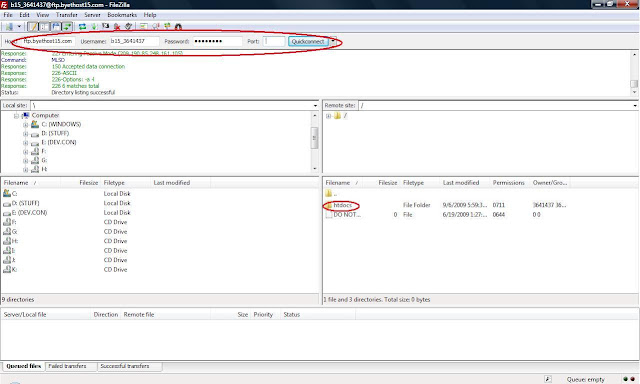Web Publishing stands for
uploading or ‘publishing’ your website on the internet so others can view it. There
are many ways of publishing our websites; if we have our own internet presence
(i-e a valid internet connection with a valid IP address) we can make our own
computer an internet server. We’ll however need a very fast connection to serve
so many users’ requests simultaneously. So we need an alternative!
Web Hosts
A Web host is a person or a
company who has very fast internet connections and very reliable computers with
multi-way backups to ensure robust service. It ‘Hosts’ our websites for us, so
our users can connect to those servers and view them. Normally web hosts charge
us a small fee(usually $3-10 a month).But
some are free too!
Some Web hosting Terms
Some terms related to web-hosting
are:
- Web-Space (The space that the host is willing to allot us so we can put our documents and any files there)
- Bandwidth (The amount of data per month that can be downloaded from or uploaded to our website)
- Server Technologies (Support for advanced technologies like Php, MySQL etc)
- Ads (Advertisements) The web host usually puts advertisements on your website, so when the user clicks on them the web host gets paid, this accounts for the free hosting!
A website with Ads
Free Vs Paid Web Hosting
It is a logical question, if free
web hosting is sufficient for our website, why paid hosting? The answer is,
paid hosting provides corporate level reliability, more webspace, more
bandwidth, no advertisements, and quick support from the admin team of the
host.
Finding a good Free Host
Finding a good free host is easy, the most easy way is to ‘Google’
it! Open www.google.com and
write “free web hosts” in the search box. You’ll get a list of web
directories and web hosts, the web directories are actually like telephone
directories, only they list free and paid web hosts!
Googling!
Some popular free webhosts
Some good free webhosts are:
www.byethost.com
(5Gb Web space, 200GB bandwidth, Email features, Control panel, Php MySQL, No
ads etc)
www.awardspace.com(
200mb web space, 5GB Bandwidth, Php Mysql, etc)
Sites.google.com (Google’s web page service offering step by
step setup instructions)
Uploading a web-page
Lets say we have created a webpage
and want to upload it to a free web host. First we usually need to register
with the free web host The registration (or signup) link is always prominent on
the front page of the webhost, for-example www.byethost.com
Byethost’s Signup link
Post-Signup
Once you click on the signup link,
you’ll be given a form to fill which usually requires your email id. Once you
submit that form, you’ll receive your account details as an email message. In
those details are your FTP user name and password, also the host name for FTP
access. You’ll be using FTP to upload your websites.
Byethost.com’s Signup mail
Using FTP Clients
An FTP client is software that
allows us to upload or download data to FTP servers. There are freeware FTP
clients available like filezilla. Filezilla is a very powerful, yet easy to use
FTP client, you can get it from:
Using FileZilla
We need to define an FTP host and
assign a username/password to it first. We can do that in the quick-connect bar
on the top. Upon clicking the “Quick Connect” button, we’ll be logged into the
FTP server and we’ll be able to view the folders on the server, we must upload
our site inside the ‘htdocs’ or ‘www’ folder.
Filezilla Environment
Accessing the website
We’re usually given a sub-domain
with the free webhosting account, we’ll be using that subdomain to access our
website. If we uploaded the webpage directly inside the htdocs folder we’ll
access it directly using the subdomain. For example, If our page is named
“index.html” and our subdomain is “qaiser.byethost15.com” we can access it by
the address : http://qaiser.byethost15.com/index.html
Sub-Domain vs Top-level-Domain
l A
Top-Level-Domain (or TLD) is an english like representation of a webserver.
l IPs
are hard to remember so we use domain names.
l Example:
www.byethost.com is a
TLD.
l Subdomains
are a small part of the TLD, like qaiser.byethost.com is a subdomain, part of
the TLD byethost.com.
l Unlike
subdomains TLDs usually have a price, ranging from $8 to $20.
l
Types of TLDs
A TLD maybe :
- .com (company)
- .net (network)
- .org (organization)
- .tv (Television/video)
- .edu (Educational)
- .gov( Government)
Etc
Acquiring a TLD
We can obtain our own Top level
domain from domain registrars. Example of a popular domain registrar is www.godaddy.comWe must pay
them via credit card and they’ll inturn register the domain for us.They will
supply us with a control panel where we can link the domain name with our
website/host. We link a TLD to our host by specifying nameservers(of the host)
in the domain control panel(we obtain the nameservers with our free/paid
hosting account automatically). Some registrars may provide TLD’s for free eg:
.co.cc and .tk domains.





There are different power plans to choose from hosting coupon, depending on the size of your site and how powerful you want your site’s performance to actually be, to avoid site downtime.click here
ReplyDelete